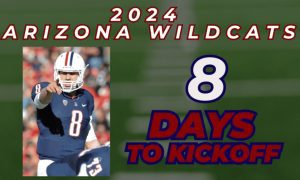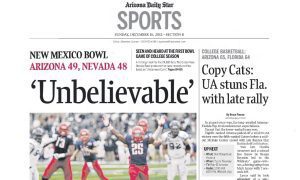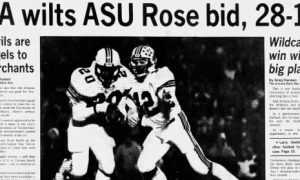FOLLOW @JAVIERJMORALES ON TWITTER!
[rps-paypal]

[ezcol_1half id=”” class=”” style=””]
Thoughts about Nevada vs. Arizona tomorrow while wondering why the neighboring-state schools have not played each other in the regular season since 1941 …
Former Arizona quarterback Nick Foles will go against former Nevada quarterback Colin Kaepernick when the Philadelphia Eagles travel to the San Francisco 49ers on Sept. 28. The college teams of Foles and Kaepernick — the best quarterbacks in the history of each program — square off Saturday night at Arizona Stadium. Too bad the schedule gods did not make both games in the same weekend.
Both young quarterbacks are evolving into the face of each of their franchise. They are one year apart with Kaepernick entering the NFL in 2011, when Foles was a senior at Arizona. How’s this for a similarity? Kaepernick’s career passing yards at Nevada: 10,098. Foles’ career passing yards at Michigan State and Arizona: 10,068.
[/ezcol_1half]
[ezcol_1half_end id=”” class=”” style=””]
[/ezcol_1half_end]

Nick Foles

Colin Kaepernick
The most important number for Foles will be after this season, when he is available to negotiate a new contract with the Eagles.
The 49ers signed Kaepernick to a 6-year, $126 million ($61 million of it guaranteed) contract after last season, prompting Philadelphia sports media to inquire how that may affect Foles’ contract restructure after this season.
Foles can negotiate a new contract because he will compete his third season. He will receive “only” $615,000 this year comparatively to other quarterbacks and his important stature with the franchise.
The $61 million guaranteed to Kaepernick is the most money ever given to a quarterback and should serve as a significant negotiating tool for Foles provided he has a productive season. So far so good, despite a horrid first half last week in the opener last week against Jacksonville. Foles responded with 322 yards passing. He had two fumbles and one pick in the first 20 minutes after he had only four turnovers (two fumbles, two INTs) in a breakout season last year that ended with him being offensive MVP of the Pro Bowl. …

The front page of the Tucson Citizen on Oct. 11, 1941, when Nevada last played Arizona in the regular season. The game was in Tucson. Notice the Wilbur vs. Wolf Pack mascot drawing similar to what this site runs 73 years later.
[ezcol_1half id=”” class=”” style=””]
— So why the long wait to play each other in the regular season (since 1941)? The teams have only played each other only four times with Arizona having a 2-1-1 edge. Arizona last played Nevada in the historic comeback win in the New Mexico Bowl in 2012.
The reason: Nevada was a Division II independent before joining the Big Sky as a Division I-AA in 1979. As recently as 1991, the Wolf Pack made the quarterfinals of the Division I-AA playoffs.
Nevada advanced to Division I-A in 1992 — the year Arizona’s Desert Swarm defense came to life — when it joined the Big West Conference. The programs did not come together until the New Mexico Bowl. They scheduled this home-and home arrangement (Arizona travels to Reno, Nev., next year) on April 29, 2009, when Chris Ault coached Nevada and Mike Stoops was at Arizona.
[/ezcol_1half]
[ezcol_1half_end id=”” class=”” style=””]
[/ezcol_1half_end]

Cody Fajardo was a teammate at Anaheim (Calif.) Servite High School with little-used Arizona senior safety Blake Brady, who had four tackles when the teams faced each other in the 2012 New Mexico Bowl
For the record, the 1941 game, won by Arizona 26-7, was played in front of 9,000 at Arizona Stadium, which had a capacity of 11,000 at the time. Arizona quarterback Robert Ruman accounted for three touchdowns, two of them passes to Hank Stanton and Mat Matulis. Arizona coach Miles Casteel’s team won the game marred by penalties, 176 yards in all for both teams. …
— Arizona goes from playing one of the most experienced FBS teams — UTSA, with 20 starters returning from last year — to playing one of the youngest. Nevada has the ninth-most freshmen and sophomores on a roster (68.3 percent) in the nation. Nevada has 48 freshmen and 23 sophomores.
By comparison, Arizona has 46 freshmen and 23 sophomores, which comprises 61.1 percent of its roster. The Wildcats have 23 juniors and 21 seniors.
Nevada fifth-year senior quarterback Cody Fajardo, who threw for three touchdowns and ran for another in the New Mexico Bowl loss to Arizona in 2012, is one of the oldest players on the Wolf Pack roster at 22 years old.
The other quarterbacks Arizona has faced to this point — Blake Decker of UNLV and Tucker Carter of Texas-San Antonio — are also old by college football standards. Decker will turn 24 on Sept. 28. Carter is 23.
Decker, Carter and Fajardo average 22.7 years old compared to 19-year-old Anu Solomon of Arizona. Solomon has defeated Decker and Carter to this point, not throwing an interception while they threw two.
— Although Nevada is not in a Power 5 conference (Pac-12, SEC, Big Ten, Big 12 and ACC), its coach Brian Polian is familiar with big-time college football and the NFL.
Before his hire at Nevada on Jan. 11, 2013 — less than a month after Ault stepped down following the loss to Arizona — Polian’s previous three stops were as an assistant at Notre Dame, Stanford and Texas A&M.
He is the son of former NFL executive Bill Polian, one of the most knowledgeable analysts to be heard at ESPN.
Brian Polian, only 39, has coached under Charlie Weis at Notre Dame, Jim Harbaugh and David Shaw at Stanford and Kevin Sumlin at Texas A&M. He has coached special teams at each spot and has also coached defensive backs, linebackers, safeties and tight ends. He was also a graduate assistant under Nick Saban at Michigan State in 1997.
Polian said in his weekly press conference that he also picked Rich Rodriguez’s brain about being a head coach before his hire at Nevada.
In his last and only visit to Arizona Stadium as a coach in 2011 with Stanford, the Cardinal won 37-10 behind Andrew Luck’s 325 yards and two touchdown passes.
— Behind Fajardo’s leadership as a senior captain, Nevada has shown efficiency with its red-zone offense and defense and ability to convert on third downs — significant areas of concern for Rodriguez. Arizona’s offense struggled in the red zone last week at Texas-San Antonio, and Rodriguez has been critical of the Wildcats’ ability on defense to get three-and-outs particularly in the first half.
Breaking down #ArizonaWildcats' red zone struggles against UTSA & options for improvement: http://t.co/3bcYhkns5n #BearDown
— WildcatUniverse.com (@Scott_Terrell) September 8, 2014
Nevada is one of four FBS teams to rank in the top 10 in red zone offense and defense. Kansas, LSU and Ohio are the others. The Wolf Pack are tied for first in red zone offense with 42 teams, scoring in 8-of-8 red zone possessions, seven of which went for touchdowns.The Wolf Pack rank fourth in the nation in red zone defense, allowing opponents to score just three times in seven red zone trips entering this week’s games. BYU and Southern Mississippi are the only other teams to deny an opponent in the red zone on four or more occasions.
Nevada ranks 28th in the nation in third-down conversions at 50 percent (20 of 40). Its defense ranks 24th in third-down defense at 27.6 percent (8 of 29).
Arizona has also scored on all of its red zone possessions (9 for 9) but only four by touchdown. Last week against UTSA, Arizona entered the red zone five times and came away with only one touchdown. Opponents have entered the red zone six times, scoring five times (the only failure a missed field goal by UTSA last week).
Arizona’s defense on third downs has tightened considerably in the second halves of the first two games. The Wildcats have allowed opponents to covert 6-of-17 (35.6 percent) of third downs in the first half and only 1-of-10 (10 percent) in the second half. Opponents have gained just 51 yards on 25 rush attempts, only 2.04 yards per rush, in the second half.
At least Arizona’s defense adjusts and seems to gets stronger as the game goes along. Any coach will take that.
ALLSPORTSTUCSON.com publisher, writer and editor Javier Morales is a former Arizona Press Club award winner. He also writes articles for Bleacher Report and Lindy’s College Sports.


























